Don't wanna be here? Send us removal request.
Text

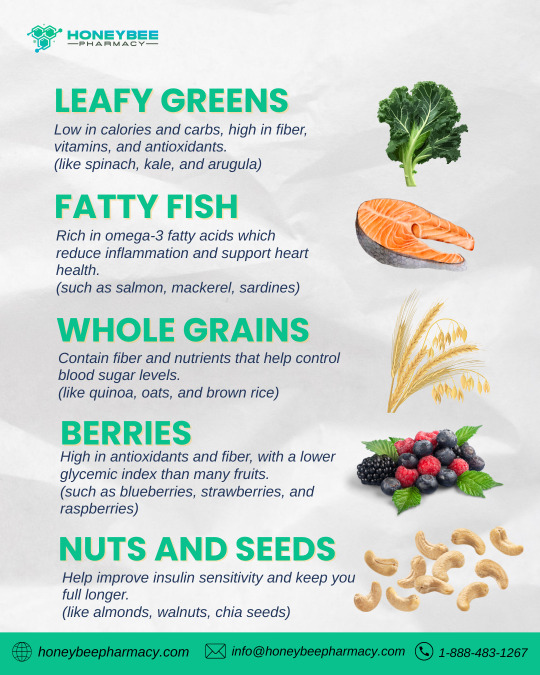
5 Best Foods for Diabetics: Smart Choices for Better Blood Sugar Control
Managing diabetes doesn’t mean giving up tasty food—it means making smarter choices. A healthy diet plays a key role in keeping blood sugar levels stable and reducing the risk of complications. Whether you’ve just been diagnosed or are looking to improve your eating habits, here are five of the best foods that can help support your journey toward better health.
1. Leafy Greens
Spinach, kale, arugula, and other leafy greens are low in calories and carbohydrates but packed with fiber, vitamins, and minerals. They help slow the absorption of sugar in the blood and are rich in antioxidants that protect against inflammation and cell damage.
Tip: Add greens to smoothies, salads, or soups for an easy nutrient boost.
2. Fatty Fish
Salmon, sardines, mackerel, and trout are excellent sources of omega-3 fatty acids. These healthy fats can help reduce inflammation, lower triglycerides, and protect heart health—important for people with diabetes who are at higher risk of heart disease.
Tip: Aim for two servings of fatty fish per week, either grilled, baked, or pan-seared.
3. Whole Grains
Unlike refined grains, whole grains like quinoa, oats, brown rice, and barley are high in fiber, which helps manage blood sugar spikes. Fiber also aids digestion and keeps you feeling full longer.
Tip: Replace white rice or white bread with brown rice or whole grain options to improve blood sugar response.
4. Berries
Berries—such as blueberries, strawberries, raspberries, and blackberries—are rich in antioxidants, fiber, and vitamins. They have a relatively low glycemic index and are a sweet way to curb cravings without causing major blood sugar spikes.
Tip: Enjoy a handful of fresh berries as a snack or add them to yogurt or oatmeal.
5. Nuts and Seeds
Almonds, walnuts, chia seeds, and flaxseeds are packed with healthy fats, protein, and fiber. They can improve insulin sensitivity and help control appetite. Just be mindful of portion sizes, as nuts are calorie-dense.
Tip: Sprinkle seeds on salads or grab a small handful of nuts for a satisfying snack.
Final Thoughts
Incorporating these five diabetes-friendly foods into your daily routine can help you take control of your blood sugar and improve your overall health. As always, consult with a healthcare provider or registered dietitian before making significant dietary changes—especially if you're managing diabetes or taking medications.
Small changes can lead to big results. Start today, one bite at a time!
#bloodsugarcontrol#type2diabetes#diabetessupport#diabetesawareness#healthyliving#healthylifestyle#diabetesdiet#weightlosstips#diabetestips#managediabetes
0 notes
Text

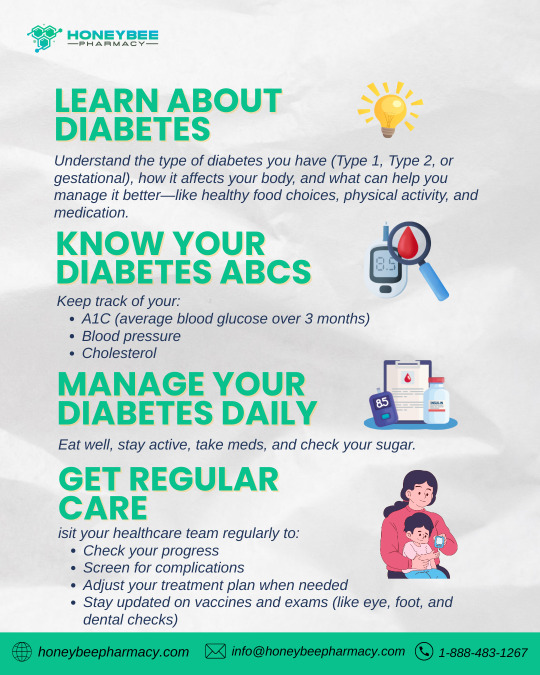
4 Steps to Manage Your Diabetes for Life
Living with diabetes doesn’t mean giving up on the life you love — it means learning how to take care of yourself every day. Whether you're newly diagnosed or have been managing diabetes for years, these four simple steps can guide you toward a healthier, happier life:
🔹 1. Learn About Diabetes Knowledge is power. The more you understand your type of diabetes (Type 1, Type 2, or gestational), the more confident you’ll feel managing it. Learn how food, movement, medications, and stress affect your blood sugar.
🔹 2. Know Your ABCs Stay on top of your key health numbers:
A1C (your average blood sugar over 3 months)
Blood Pressure
Cholesterol These are essential to prevent heart disease, stroke, and other complications.
🔹 3. Make Healthy Choices Every Day
Eat balanced meals with fiber, lean protein, and low sugar.
Move your body — even a daily walk helps!
Take your meds as prescribed.
Monitor your blood glucose levels.
Manage stress and get enough sleep.
🔹 4. Get Regular Checkups Your healthcare team is your support system. Schedule regular visits to:
Track your progress
Adjust your treatment plan
Catch any problems early
Stay on top of dental, eye, and foot care
💬 Reminder: “Managing diabetes isn’t a one-time task — it’s a lifelong commitment to learning, living well, and staying in control one step at a time.”
✨ You’ve got this. One step at a time. One healthy choice at a time. ✨
#DiabetesCare#DiabetesManagement#ChronicIllness#Type2Diabetes#HealthTips#SelfCare#BloodSugarControl#WellnessJourney#HealthyHabits
4 notes
·
View notes
Text
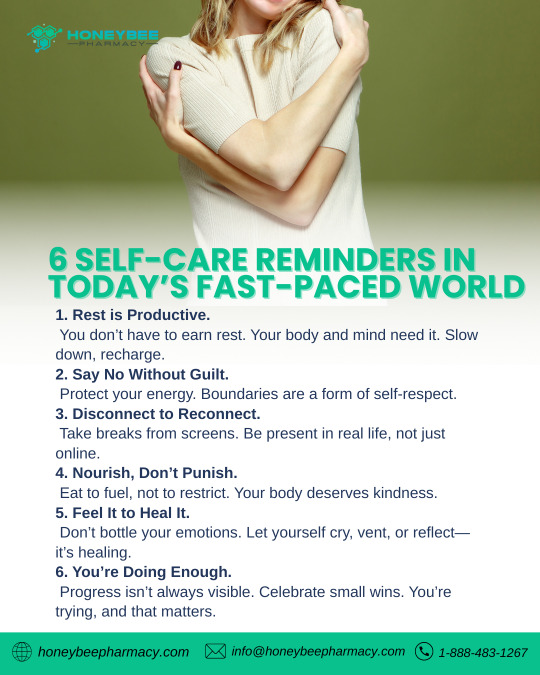
6 self-care reminders in today’s fast-paced world
1. Rest is Productive. You don’t have to earn rest. Your body and mind need it. Slow down, recharge.
2. Say No Without Guilt. Protect your energy. Boundaries are a form of self-respect.
3. Disconnect to Reconnect. Take breaks from screens. Be present in real life, not just online.
4. Nourish, Don’t Punish. Eat to fuel, not to restrict. Your body deserves kindness.
5. Feel It to Heal It. Don’t bottle your emotions. Let yourself cry, vent, or reflect—it’s healing.
6. You’re Doing Enough. Progress isn’t always visible. Celebrate small wins. You’re trying, and that matters.
#SelfCareReminders#MentalHealthMatters#SetBoundaries#DigitalDetox#bloodsugarcontrol#HealthyMindHealthyBody#YouAreEnough#DailyInspo
0 notes
Text


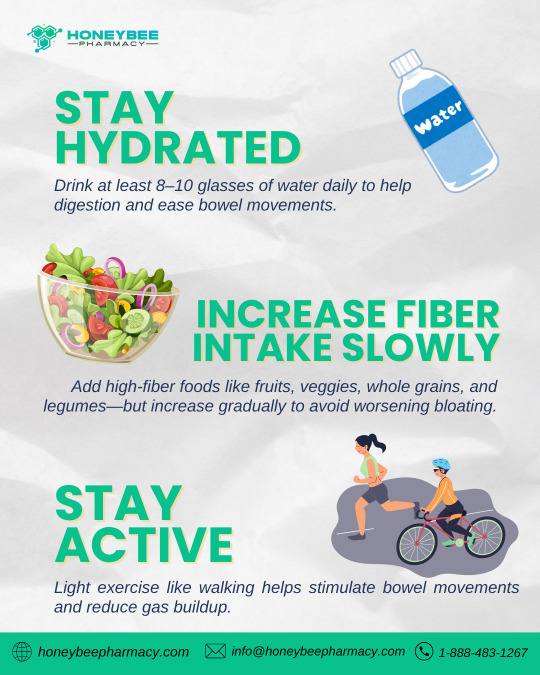
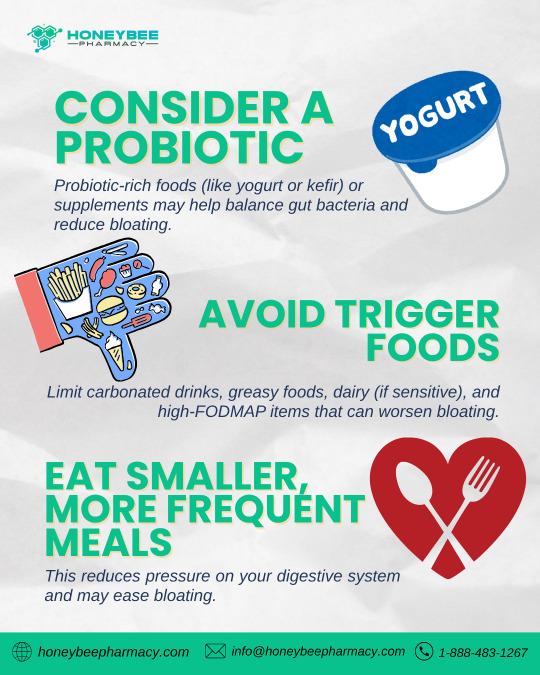
Feeling bloated or constipated while on Mounjaro? You're not alone. Learn simple tips to relieve Mounjaro-related constipation and bloating—like staying hydrated, eating more fiber, and moving your body. 💧🥗🚶♀️ Take control of your gut health and feel better every week!
#MounjaroTips#ConstipationRelief#BloatingRemedies#MounjaroSideEffects#DigestiveHealth#Type2DiabetesSupport#WeightLossJourney#HealthyGut#BloodSugarControl
0 notes
Text
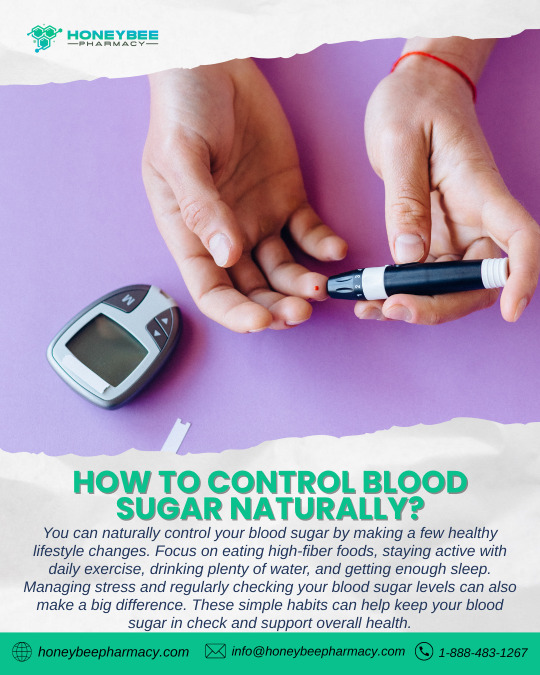
Here are simple and effective ways to control blood sugar naturally:
✅ 1. Eat Balanced Meals
Choose high-fiber foods like vegetables, legumes, and whole grains.
Include lean protein (chicken, fish, tofu) and healthy fats (avocado, nuts).
Limit refined carbs and sugar.
✅ 2. Exercise Regularly
Aim for 30 minutes a day of walking, cycling, or other moderate activity.
Exercise helps muscles use glucose more efficiently.
✅ 3. Stay Hydrated
Drink plenty of water throughout the day.
Water helps flush out excess sugar through urine.
✅ 4. Manage Stress
Chronic stress can spike blood sugar.
Practice deep breathing, meditation, or yoga.
✅ 5. Get Enough Sleep
Poor sleep affects insulin sensitivity.
Aim for 7–9 hours of quality sleep nightly.
✅ 6. Monitor Your Blood Sugar
Keep track of your levels to understand patterns and make adjustments.
✅ 7. Use Natural Supplements Wisely
Some people benefit from cinnamon, berberine, or apple cider vinegar.
Always check with a healthcare provider before starting supplements.
#BloodSugarControl#NaturalDiabetesTips#LowerBloodSugarNaturally#HealthyLiving#DiabetesSupport#type2diabetes#diabetesawareness#healthylifestyle#diabetesdiet#diabetestips#weightlosstips#managediabetes
0 notes
Text

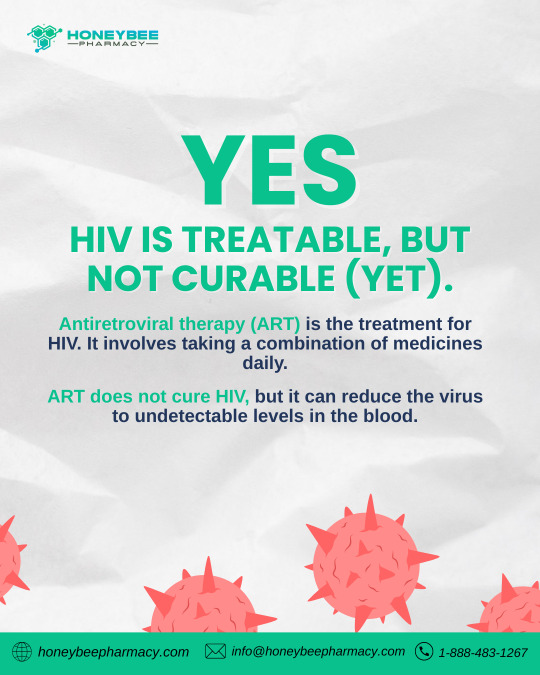
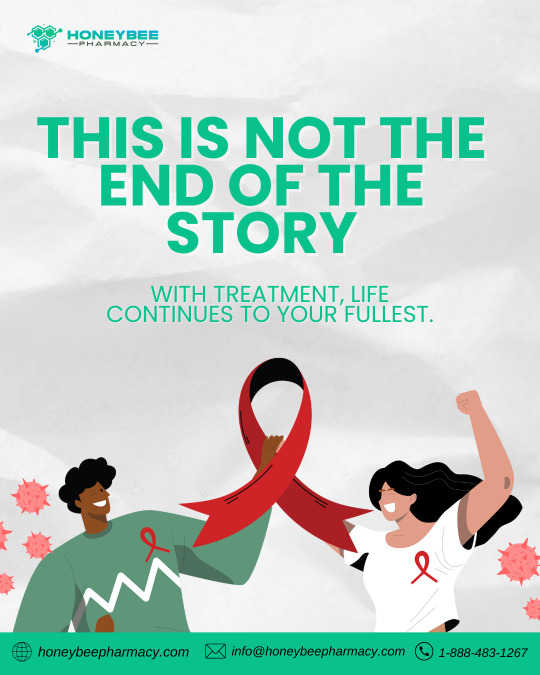
HIV is treatable — and with the right care, life goes on. 💪 Thanks to antiretroviral therapy (ART), people living with HIV can live long, healthy lives. When the virus becomes undetectable, it can't be passed on to others. This is what we mean by U=U — Undetectable = Untransmittable.
With treatment, life continues to your fullest. 🌈❤️
0 notes
Text
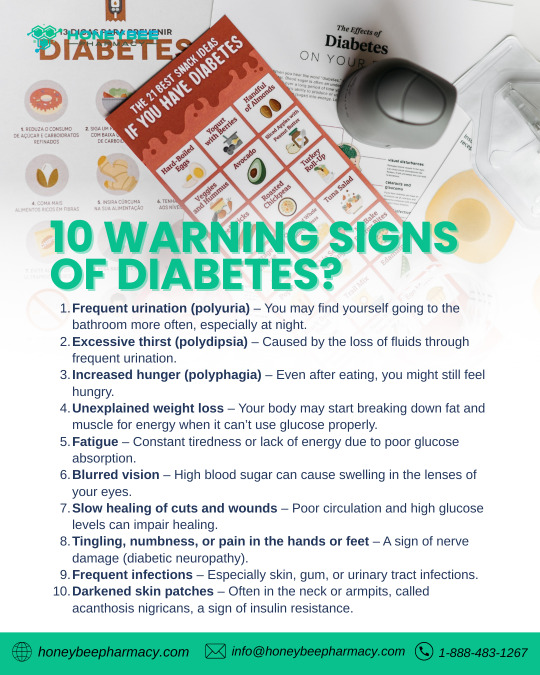
Here are 10 common warning signs of diabetes you should watch out for:
Frequent urination (polyuria) – You may find yourself going to the bathroom more often, especially at night.
Excessive thirst (polydipsia) – Caused by the loss of fluids through frequent urination.
Increased hunger (polyphagia) – Even after eating, you might still feel hungry.
Unexplained weight loss – Your body may start breaking down fat and muscle for energy when it can’t use glucose properly.
Fatigue – Constant tiredness or lack of energy due to poor glucose absorption.
Blurred vision – High blood sugar can cause swelling in the lenses of your eyes.
Slow healing of cuts and wounds – Poor circulation and high glucose levels can impair healing.
Tingling, numbness, or pain in the hands or feet – A sign of nerve damage (diabetic neuropathy).
Frequent infections – Especially skin, gum, or urinary tract infections.
Darkened skin patches – Often in the neck or armpits, called acanthosis nigricans, a sign of insulin resistance.
If you notice any of these signs, it's important to consult a healthcare professional for screening and diagnosis. Early detection can help prevent serious complications.
#DiabetesAwareness#WarningSignsOfDiabetes#DiabetesSymptoms#Type2Diabetes#BloodSugarCheck#HealthyLiving#DiabetesSupport#PreventDiabetes#KnowTheSigns
0 notes
Text


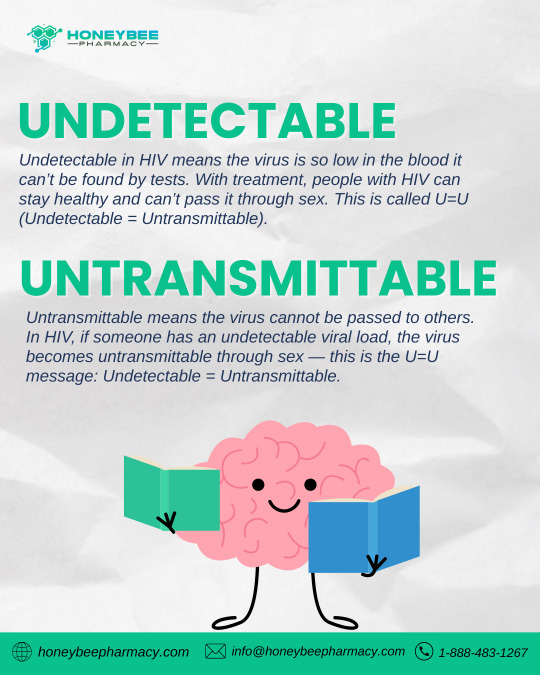

📢 HIV Awareness: What Does U = U Mean? 🧬
U = U stands for Undetectable = Untransmittable — if a person with HIV is on treatment and reaches an undetectable viral load, they can’t transmit the virus through sex. 💊❤️ It's a message of hope, health, and zero stigma. #UequalsU #HIVAwareness #UndetectableUntransmittable #StopTheStigma #KnowYourStatus #EndHIV
0 notes
Text
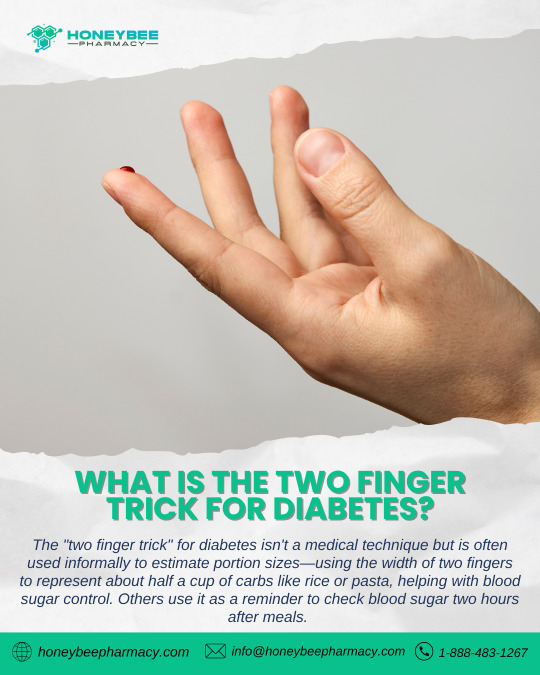
The "two finger trick" for diabetes isn't a standardized medical term, but it's often mentioned informally in social media and wellness circles. It typically refers to one of the following concepts:
1. Portion Control or Carb Estimation
Using two fingers (usually the index and middle finger) to estimate portion sizes of carbohydrate-rich foods like rice or pasta. For example:
The width or thickness of two fingers can represent one serving (about ½ cup) of carbs.
This helps people with diabetes visually manage their carb intake to avoid blood sugar spikes.
2. Post-Meal Blood Sugar Monitoring
Some refer to the "two finger trick" as a reminder to:
Check blood sugar levels 2 hours after eating (using one finger to poke and the second to track time).
This can help assess how your body is responding to meals and guide dietary adjustments.
3. Vagus Nerve Stimulation
In some alternative circles, lightly pressing two fingers on the neck or chest is claimed to stimulate the vagus nerve, potentially helping with digestion and glucose regulation. However, this is not scientifically proven for diabetes management and should not replace medical treatment.
Important Note:
There’s no clinical evidence that the "two finger trick" is a standalone or effective method to treat or manage diabetes. It may be a visual aid or self-monitoring cue, but it should always be used alongside medical advice and established diabetes care plans.
#bloodsugarcontrol#type2diabetes#diabetessupport#healthyliving#diabetestips#diabetesawareness#diabetesdiet#managediabetes#weightlosstips
0 notes
Text

5 of the best foods for diabetics, chosen for their ability to help manage blood sugar levels while supporting overall health:
1. Leafy Greens (e.g., spinach, kale, collard greens)
Benefits: Low in carbohydrates and calories, high in fiber, vitamins (like vitamin C), and antioxidants.
Why it’s great: Helps reduce inflammation and may improve insulin sensitivity.
2. Fatty Fish (e.g., salmon, sardines, mackerel)
Benefits: Rich in omega-3 fatty acids (EPA and DHA), which support heart health.
Why it’s great: Diabetes increases the risk of heart disease, and fatty fish can help lower this risk.
3. Whole Grains (e.g., quinoa, oats, brown rice)
Benefits: High in fiber, especially soluble fiber, which slows digestion and prevents blood sugar spikes.
Why it’s great: Improves glycemic control and promotes satiety.
4. Legumes (e.g., lentils, chickpeas, black beans)
Benefits: Packed with fiber, protein, and complex carbs.
Why it’s great: They have a low glycemic index and can help stabilize blood sugar.
5. Berries (e.g., blueberries, strawberries, raspberries)
Benefits: High in antioxidants, fiber, and vitamins, yet relatively low in sugar.
Why it’s great: Satisfies sweet cravings without spiking blood sugar levels.
#diabetesawareness#diabetessupport#healthyliving#diabetestips#diabetesdiet#type2diabetes#bloodsugarcontrol#managediabetes
0 notes
Text

Why Is My Morning Blood Sugar High? Tips to Keep It in Check
Waking up with high blood sugar can be frustrating—especially if you’ve been careful with your diet and medication. This early spike is often caused by the dawn phenomenon, a natural hormonal change that happens in the early morning hours. During this time, the body releases hormones like cortisol and growth hormone, which can raise blood sugar levels—especially in people with diabetes.
How to Prevent High Morning Blood Sugar
Check Your Blood Sugar at Night Monitor your levels before bed and between 2–3 a.m. to spot trends and share them with your healthcare provider.
Limit Evening Carbs Heavy carb meals or sugary snacks at night can lead to higher glucose levels in the morning. Choose a light, balanced dinner and opt for a protein-rich bedtime snack if needed.
Stay Active Regular physical activity, especially after meals, can improve insulin sensitivity and help regulate blood sugar overnight.
Adjust Medications If Needed Speak with your doctor about your medication or insulin regimen—sometimes timing or dosage adjustments are necessary.
Get Quality Sleep Poor sleep can impact hormone levels and blood sugar. Aim for 7–9 hours of restful sleep each night.
By making small changes to your evening habits and staying in tune with your body, you can better manage morning blood sugar levels and start your day on a healthier note.
#bloodsugarcontrol#type2diabetes#healthylifestyle#diabetessupport#diabetestips#weightlosstips#diabetesawareness#healthyliving#diabetesdiet#managediabetes
0 notes
Text
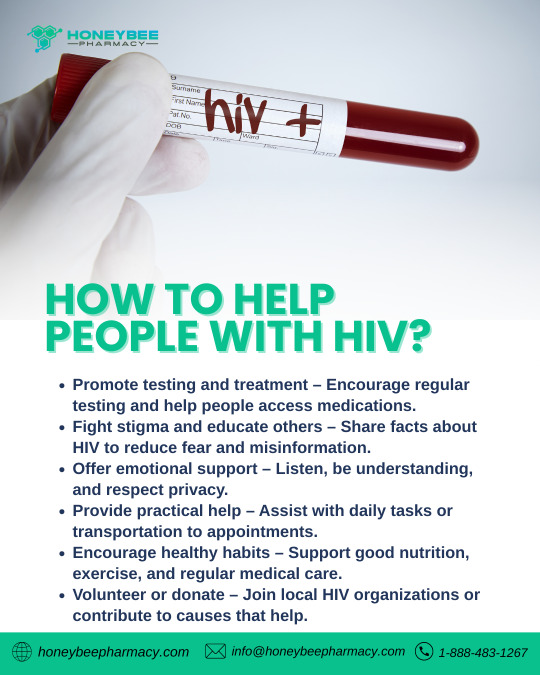
Helping people with HIV can be done in many meaningful ways, focusing on compassion, support, and practical assistance. Here are some key steps:
1. Promote Understanding and Reduce Stigma
Educate yourself and others about HIV, how it’s transmitted, and the realities of living with HIV today.
Challenge myths and stereotypes to reduce fear and stigma.
2. Encourage Testing and Treatment
Promote HIV testing in your community to help people know their status.
Support access to antiretroviral therapy (ART), which helps people with HIV live healthy lives and reduces transmission risk.
3. Offer Emotional Support
Be a good listener. Let them share feelings without judgment.
Respect confidentiality. HIV status is private, so never share it without permission.
4. Provide Practical Help
Assist with appointments, transportation, or paperwork.
Help with daily needs, like meals, errands, or childcare, if they’re facing challenges.
5. Promote a Healthy Lifestyle
Encourage regular medical care, a balanced diet, exercise, and good sleep.
Discourage smoking, excessive alcohol, or drug use, which can weaken the immune system.
6. Advocate for Their Rights
Fight discrimination at work, school, and in healthcare settings.
Support organizations that protect the rights of people with HIV.
7. Volunteer or Donate
Get involved with local HIV/AIDS organizations that offer services, support, and advocacy.
Donate to causes that provide treatment, prevention, and education.
0 notes
Text

Controlling diabetes involves a combination of medical management, lifestyle changes, and ongoing monitoring. Here’s a breakdown:
1. Medical Management:
Medications: For type 1 diabetes, insulin therapy is essential. For type 2 diabetes, medications like metformin, sulfonylureas, SGLT2 inhibitors, GLP-1 agonists, or insulin may be used depending on the case.
Regular monitoring: Blood glucose checks help ensure levels stay within a healthy range.
2. Lifestyle Changes:
Healthy Eating: Focus on balanced meals with complex carbs (whole grains, veggies), lean proteins, and healthy fats. Limit added sugars and refined carbs.
Regular Exercise: At least 150 minutes of moderate-intensity activity per week, like brisk walking or swimming.
Weight Management: For overweight individuals, even a modest weight loss (5-10%) can improve insulin sensitivity.
3. Stress Management & Sleep:
Chronic stress and poor sleep can raise blood sugar levels. Practices like meditation, yoga, and good sleep hygiene help.
4. Regular Check-ups:
Eye, foot, and dental exams.
Monitoring blood pressure and cholesterol to lower cardiovascular risks.
5. Continuous Learning & Support:
Diabetes education programs, support groups, or apps can help you stay on track.
#DiabetesCare#bloodsugarcontrol#healthylifestyle#diabetessupport#type2diabetes#diabetesawareness#weightlosstips#diabetesdiet#diabetestips
0 notes
Text
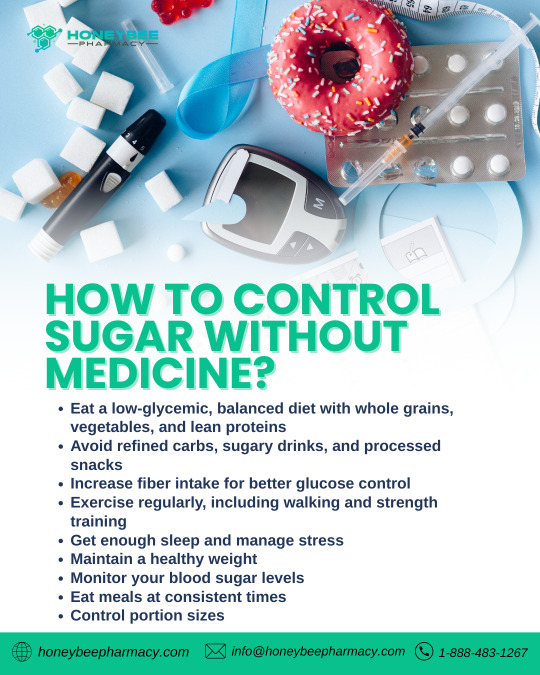
✅ Diet and Nutrition
🍽 Eat a balanced, low-glycemic diet – Focus on whole grains, vegetables, lean proteins, and healthy fats.
🍓 Avoid refined carbs and added sugars – Limit sweets, soda, white bread, and processed snacks.
🥦 Increase fiber intake – Fiber slows down sugar absorption and helps regulate blood glucose.
🧃 Choose water or unsweetened drinks – Avoid sugary beverages and fruit juices.
🏃♂️ Physical Activity
🚶♀️ Exercise regularly – Aim for at least 30 minutes of moderate activity (like walking) most days.
🧘 Try resistance training and yoga – These improve insulin sensitivity and lower stress levels.
🛌 Lifestyle Habits
😴 Get enough sleep – Poor sleep can affect insulin response and blood sugar levels.
😌 Manage stress – Chronic stress raises cortisol, which can spike blood sugar. Practice mindfulness or deep breathing.
⚖️ Maintain a healthy weight – Even modest weight loss can improve insulin sensitivity.
📈 Monitoring and Habits
📝 Monitor your blood sugar levels – Keep track to understand patterns and triggers.
🕒 Eat meals at regular times – Helps prevent blood sugar spikes and crashes.
🍽 Control portion sizes – Avoid overeating even healthy foods.
#LowerBloodSugarNaturally#BloodSugarControl#NaturalDiabetesTips#HealthyLifestyle#NoMedicationNeeded#Type2DiabetesSupport#BalancedDiet
0 notes
Text

Yes, walking for 30 minutes a day can help lower blood sugar levels—especially for people with type 2 diabetes or prediabetes.
How It Works:
Improves insulin sensitivity: Regular walking helps your muscles use insulin more efficiently, which means your body can move glucose (sugar) from your blood into your cells more effectively.
Burns glucose: Physical activity like walking burns glucose for energy, directly lowering blood sugar.
Reduces insulin resistance: Over time, daily walking can reduce insulin resistance, a key issue in type 2 diabetes.
Timing Matters:
Post-meal walks: Walking 10–30 minutes after meals, especially after your largest meal, can be particularly effective at reducing blood sugar spikes.
Other Benefits:
Helps with weight management
Supports cardiovascular health
Reduces stress, which also helps control blood sugar
Tips:
Wear comfortable shoes.
Stay hydrated.
Track your blood sugar to see how your body responds.
Even small steps make a difference—consistency is key!
#LowerBloodSugar#Type2Diabetes#BloodSugarControl#HealthyHabits#WalkForHealth#InsulinResistance#DiabetesTips#PrediabetesSupport#DailyWalk#GlucoseManagement
0 notes
Text
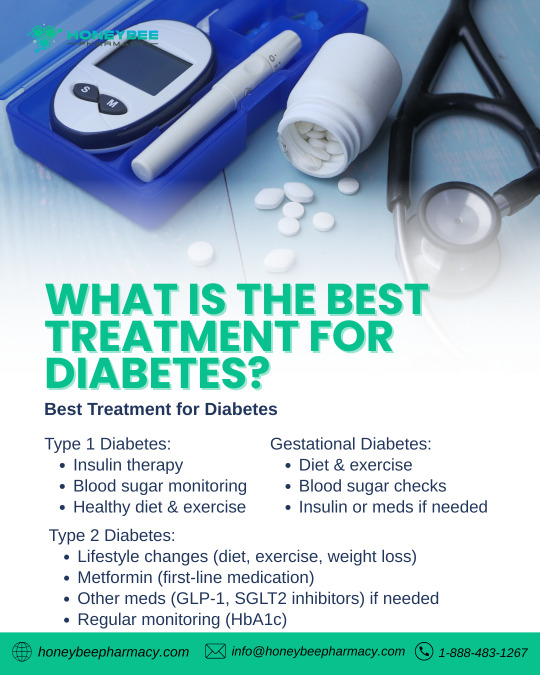
🔹 Type 1 Diabetes
This is an autoimmune condition where the body doesn't produce insulin.
Best treatment:
Insulin therapy (via injections or insulin pump)
Blood sugar monitoring (frequent checks, often with CGMs—continuous glucose monitors)
Healthy eating (balanced carbohydrates, low added sugars)
Regular physical activity
Education & support (diabetes education programs)
🔹 Type 2 Diabetes
This is a metabolic disorder where the body resists insulin or doesn’t produce enough.
Best treatment:
Lifestyle changes (first-line approach)
Weight loss (even 5–10% can help)
Healthy diet (low glycemic index, high fiber)
Regular exercise (150 minutes/week)
Medications
Metformin (first-line medication)
Others: GLP-1 receptor agonists (like Ozempic, Mounjaro), SGLT2 inhibitors, DPP-4 inhibitors, or insulin in advanced cases
Monitoring (blood sugar, HbA1c every 3–6 months)
🔹 Gestational Diabetes
Occurs during pregnancy.
Best treatment:
Diet and exercise
Blood sugar monitoring
Insulin or oral meds if lifestyle isn’t enough
Additional Recommendations for All Types:
Regular checkups (eye, kidney, and foot exams)
Mental health support (diabetes burnout is real)
Diabetes education (empowers self-management)
#DiabetesTreatment#Type1Diabetes#Type2Diabetes#GestationalDiabetes#BloodSugarControl#InsulinTherapy#Metformin#HealthyLiving#DiabetesSupport#ChronicIllnessCare#DiabetesManagement
0 notes
Text

Yes, exercise does lower blood sugar. When you exercise, your muscles use more glucose (sugar) for energy, which helps reduce the amount of glucose in your bloodstream. This is especially helpful for people with insulin resistance or type 2 diabetes because physical activity improves the body's sensitivity to insulin, allowing cells to take in glucose more efficiently.
Here’s a quick rundown of how exercise lowers blood sugar:
Muscle glucose uptake: During exercise, your muscles increase glucose uptake to fuel activity, lowering blood sugar levels.
Improved insulin sensitivity: Regular exercise helps your body respond better to insulin, making it easier to control blood sugar.
Long-term benefits: Consistent physical activity can help maintain stable blood sugar levels and reduce the risk of developing type 2 diabetes.
So, incorporating aerobic exercises (like walking, running, cycling) and resistance training (like weight lifting) into your routine can be very beneficial for managing blood sugar.
#LowerBloodSugarNaturally#ExerciseAndDiabetes#BloodSugarControl#Type2DiabetesSupport#InsulinResistance#HealthyLivingTips#FitnessForHealth#GlucoseControl
0 notes